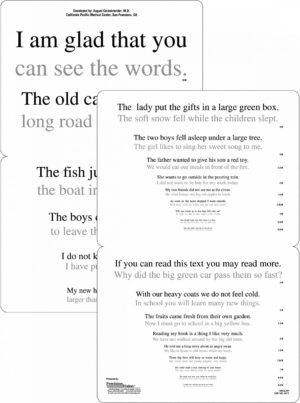IReST – International Reading Speed Texts – In Multiple Languages
- Reproducibility
- Comparability
- Success documentation
- Available in 19 languages and dialects
- 3 New Languages Coming Soon!:
Norwegian, Bengali and Tamil
- 3 New Languages Coming Soon!:
$95.00
Product Variations
Description
- Highly calibrated for reproducible results across all languages
- Available in 19 languages and dialects
- Part #4401 – English
- Part #4402-S – Spanish
- Part #4402-H – Hispanic
- Part #4403 – Brazilian/Portuguese
- Part #4404 – German
- Part #4405 – Dutch
- Part #4406 – Finnish
- Part #4407 – Swedish
- Part #4408 – Italian
- Part #4409 – French
- Part #4410 – Arabic
- Part #4411 – Chinese (Simplified)
- Part #4412 – Russian
- Part #4413 – Hebrew
- Part #4414 – Polish
- Part #4416 – Japanese
- Part #4417 – Slowenian
- Part #4418 – Turkish
- Part #4419 – Greek
- 3 New Languages Coming Soon!: Norwegian, Bengali and Tamil
- Easy to use
- Easy to handle
- Easy to measure (by stopwatch)
- Easy to calculate (normal values and formula included)
Characteristics:
- Set of 10 paragraphs of text in each language for repeated measurements
- Comparability between languages for international studies
- Natural conditions: newspaper print, meeting the demands of everyday life
Applications:
- For normal subjects
- For patients with low vision (monitoring of disease, the effect of treatment and rehabilitation)
- For patients with developmental dyslexia (severity of the reading disorder, the effect of training, etc.) – for juveniles and adults
- Low Vision patients
- Disease monitoring in AMD, especially in treatment studies
- After refractive surgery
- After multifocal intraocular lenses
- Neurological reading disorders
- Developmental dyslexia
- Studies with normal subjects
User groups:
- Ophthalmologists and neurologists
- Optometrists and ophthalmic opticians
- Orthoptists and low vision specialists
- Teachers and psychologists
- All reading researchers
The IReST differs from prior text charts that used single sentences by employing linguistically standardized paragraphs. They close a gap in the diagnostics of reading performance. The paragraphs are designed to resemble everyday life situations of reading continuous text, such as in books or newspapers. The level of difficulty corresponds to sixth-grade reading (10–12 years), which is comprehensible for teenagers and adults. Due to lower variance, measuring the reading time of a complete paragraph rather than a single sentence or random words is more reliable. Furthermore, it can provide some information about fluency, fatigue, and mistakes.
Credits:
- The first study for four languages was funded by the European Commission in the AMD Read Project. Two more languages were supported by the German Academic Exchange Office. The development of 11 more languages was supported by Alcon. An additional language supported by Allergan.
- Scientific coordinator for the IReST Study Group: Prof. Dr. Susanne Trauzett el-Klosinski (Low Vision Clinic and Research Laboratory / Centre for Ophthalmology / University of Tuebingen, Germany)





